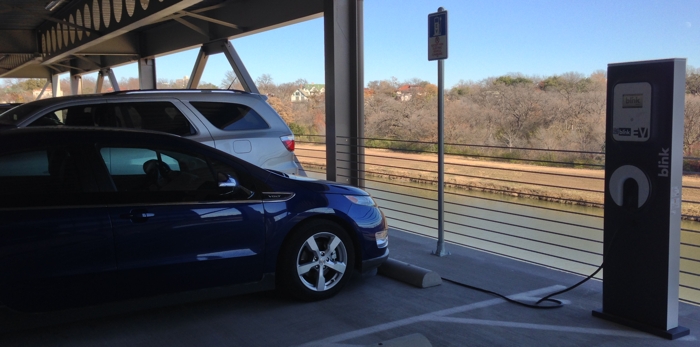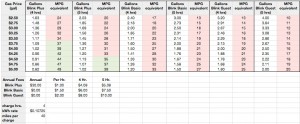 Today, I met a friend at his office to go to lunch. I had traveled far enough that I’d used slightly over half the electric miles that my Volt had predicted for the charge. My friend mentioned that he could drive us to lunch while I recharged my car at the Blink charge stations in the parking garage. I parked in the designated spot, and plugged the car in. Nothing happened. I realized that this was a Blink station where I had to pay to charge. Every one of the Blink chargers I had come across in the wild before, were free to use. Fortunately, I had my Blink membership card with me, so I waved it in front of the proper location and the charge began. The display reminded me I would be paying $1.50 per hour, since I have a Blink Basic account.
Today, I met a friend at his office to go to lunch. I had traveled far enough that I’d used slightly over half the electric miles that my Volt had predicted for the charge. My friend mentioned that he could drive us to lunch while I recharged my car at the Blink charge stations in the parking garage. I parked in the designated spot, and plugged the car in. Nothing happened. I realized that this was a Blink station where I had to pay to charge. Every one of the Blink chargers I had come across in the wild before, were free to use. Fortunately, I had my Blink membership card with me, so I waved it in front of the proper location and the charge began. The display reminded me I would be paying $1.50 per hour, since I have a Blink Basic account.
The types of Blink accounts and their terms may be found here, but here’s a quick synopsis:
- Blink Plus: $30 annual fee*, $1.00 per hour charge time**
- Blink Basic: $0 annual fee, $1.50 per hour charge time**
- Blink Guest: $0 annual fee, $2.00 per hour charge time**
*annual fee waived through 2013
**the actual wording is “as low as…” and their FAQ page says the rate may vary, based on local utility rates, which makes sense.
When I got back, the display showed the charge had been going for one hour, thirty-three minutes (1:33). When I disconnected my car, it showed the total fee to be $3.00. In other words, it charged me for two full hours instead of slightly more than an hour and a half. That made me wonder if I did not have a charger at home, and the battery had been completely drained, the full charge may have taken four hours and a few minutes. Would it have charged me for five hours? I’m not sure, I didn’t see any mention of fractional hours or how rounding of fractional hours is calculated. I was over 50% of the way into the second hour, so at the very least, we can assume that if you go over by thirty minutes, you’ve bought another hour.
That thought process took me to pondering how that fee compared to buying gasoline. My Volt has consistently gotten and average of 37 MPG when running on gas, so part of the calculation is easy. My average number of miles per full charge is around 40, so the only real variable is the cost of gasoline.
It was time to make another spreadsheet. (yay!)
I’m not going to factor in the price of the home charger, since mine was free, but I had to pay for installation and to have the circuit run (see earlier post for details). Other people, not living in a city covered by the EV Project, have to purchase their charger but have the option to install it themselves. Others may purchase the charger and pay to have someone install it, maybe they even have to have a circuit added. Due to all the permutations, I am not including the amortized cost of the charging station in my comparisons. I recommend you do, if you’re trying to determine if you should charge at home or at your workplace (should you be fortunate enough to have access to a charge station at work).
But let’s say you live in an apartment that has no charging facility and your workplace doesn’t either and you’re considering whether you should buy an electric vehicle. You really need to understand how paying for electricity compares to paying for gasoline. It’s not really miles per gallon that matters as much as it is dollars per mile. Many of us interested in EVs would buy one, even if the electricity cost slightly more than gasoline, but what if the cost was like driving a large truck that got 10 MPG? Would you then get an EV?
So here’s what I did. I had a given of an average of 40 miles per electric charge, which is what I’ve experienced so far. Therefore, if I take the cost to charge the battery from empty to full and divide it by the current cost of a gallon of gas, I get how many gallons of gas I could have bought with that amount of money. If I then take those 40 miles I can get on the full charge and divide it by the gallons of gas I just calculated, I get the effective miles per gallon I’m getting by charging at the station.
I know that seems convoluted, so here’s an example:
I charge the car completely and it takes 3 hours, 57 minutes. At $1.50 per hour, that’s $6.00 for the full charge. Gasoline is $3.00 per gallon, so the $6.00 would have bought two gallons. If I can go 40 miles on the charge, which cost the same as two gallons of gas, I effectively got 20 MPG (40 miles / two gallons).
Since I get 37 MPG when the range extender is running in my Volt, it’s a bad economic decision to use the public charger even though it’s an ecologically positive decision.
Now for the bad news: If you’re only concerned about the economics, gasoline has to be over $3.75 per gallon to break even with the cost of gasoline, and then only if you can complete the charge in under 4 hours. If you go over enough to get rounded up to 5 hours, gas has to cost more than $4.50 per gallon. Both of these scenarios are true, only if you have the Blink Plus membership. The $30 annual fee for Blink Plus only amounts to an additional $0.08 per charge if you charge every day ($30 / 365 charges). If you have a Blink Basic or Blink Guest membership, even at $5.00 per gallon for gas, you don’t break even.
Click on the image below to see the full spreadsheet.
One thing to note on the spreadsheet, the green cells show when it is less expensive to use electricity the pink areas when it is more expensive. Notice the upper-right pink cell. If you have a Blink Guest account and it takes over four hours to charge (or at least enough over that your charge time gets rounded up to 5 hours), you would be paying as much as if you drove a vehicle that got 10 miles per gallon!
Sometimes, it’s good to do the math…
Then I started wondering about the business model for the companies deploying the charging stations. If each Volt takes four hours to charge, they have a maximum of six cars that can per serviced per day and that’s only if there’s a car waiting to charge as the car before it is wrapping up. In other words, if the charger has zero downtime.
Let’s take a best case scenario. Every person charging is on the most expensive plan, Blink Guest.
- Four hours of charge time would be $8.00 of revenue, for a total of $48.00 per day.
- We’ll assume 12 kWh to fully charge the Volt (mine ranges from 12 to 12.8), so that’s 72 kWh for all six Volts.
- We’ll assume they get the same rate for electricity that I do, $0.10725 per kWh, so that’s a total cost of $7.72 for electricity.
- The maximum daily total profit would be $40.28 per charger. Of course, also coming out of that profit is the cost of the equipment, maintenance, repairs, insurance (liability and for damage or theft), the salary of any technician that checks on the charger regularly and any downtime experienced, like if no one is charging at 3:00AM.
How is it they’re going to make money and deploy these?


Comments